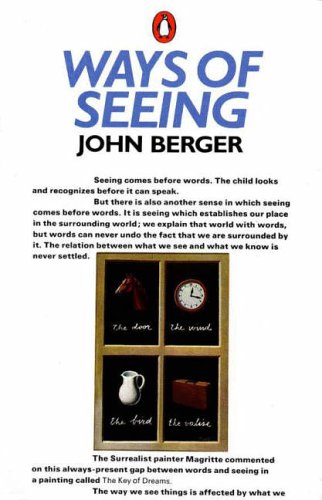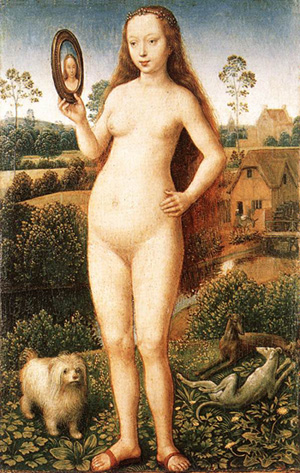
*Update: Sociological Images has videos from Ways of Seeing*
What works
John Berger’s “Ways of Seeing” is a series of 7 essays, three of which are composed of visuals only, collected into a short book. They are based on a BBC television series.
He starts the first essay:
“Seeing comes before words. The child looks and recognizes before it can speak. But there is also another sense in which seeing comes before words. It is seeing which establishes our place in the surrounding world; we explain that world with words, but words can never undo the fact that we are surrounded by it. The relation between what we see and what we know is never settled. Each evening we see the sun set. We know that the earth is turning away from it. Yet the knowledge, the explanation, never quite fits the sight.”

In one of the essays about the female nude he goes on to develop how power has been embedded in the relationship between seeing and being seen. This sort of exposition on the female nude is common in art history but made especially accessible in Berger’s short essay collection. Using Vanity by Hans Memling (above) as an example, he writes: “The mirror was often used as a symbol of the vanity of woman. The moralizing, however, was mostly hypocritical. You painted a naked woman because you enjoyed looking at her, you put a mirror in her hand and you called the painting Vanity, thus morally condemning the woman whose nakedness you had depicted for your own pleasure.”
References
Berger, John. (1972) Ways of Seeing [essay collection] London: BBC and Penguin Books.

Comments 4
Computer Internet and Technology Articles. » Blog Archive » Graphic Sociology » Ways of Seeing by John Berger — November 5, 2009
[...] Go here to read the rest: Graphic Sociology » Ways of Seeing by John Berger [...]
Tweets that mention Graphic Sociology » Ways of Seeing by John Berger -- Topsy.com — November 30, 2009
[...] This post was mentioned on Twitter by Stan, Stan. Stan said: I like this --- Ways of Seeing by John Berger http://bit.ly/5NTBqB [...]
Hypocritical economic moralizing « occasional links & commentary — November 1, 2010
[...] Just like the moralizing concerning women’s vanity in Hans Memling’s Vanity (1485). As John Berger observed, The mirror was often used as a symbol of the vanity of woman. The moralizing, however, [...]
Thought for the day: Hypocritical economic moralizing « Real-World Economics Review Blog — November 2, 2010
[...] is. Just like the moralizing concerning women’s vanity in Hans Memling’s Vanity (1485). As John Berger observed, The mirror was often used as a symbol of the vanity of woman. The moralizing, however, [...]